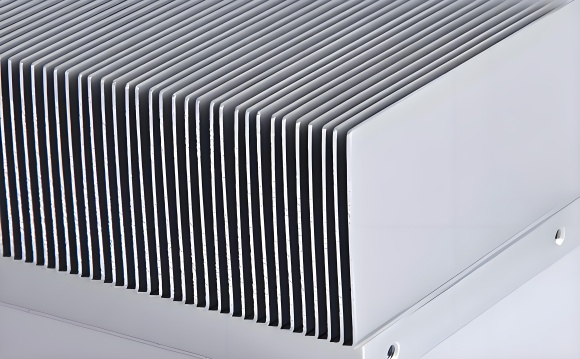Maximize Thermal Performance · Reduce Costs · Conquer High-Density Thermal Challenges
Why Aluminum Skived Heat Sinks Dominate Advanced Electronics Cooling
Aluminum Skived Heat Sinks leverage precision skiving technology to carve ultra-thin fins (as slim as 0.1mm) from solid aluminum blocks, achieving fin densities up to 40 FPI. Unlike extrusion or die-casting, skiving requires no molds, slashes lead times by 50%, and enables complex custom designs. Ideal for CPUs, GPUs, power converters, and LEDs, these heat sinks deliver unmatched thermal efficiency in compact spaces.
I. Core Technology: How Skiving Revolutionizes Heat Dissipation
- The Skiving Process Explained
- Material: High-purity aluminum alloys (1050/1100 series) with 220 W/(m·K) thermal conductivity and superior ductility.
- Precision Cutting: CNC-controlled blades cut fins at 20°–30° angles, creating seamless, continuous arrays with minimal thermal resistance.
- Surface Enhancement: Anodization boosts corrosion resistance and elevates emissivity to 0.8+ (vs. 0.2 for raw aluminum).
- Performance ComparisonParameterSkived AluminumExtrudedDie-CastMin. Fin Thickness0.1–0.5 mm≥1 mm≥1.5 mmMax. Fin Aspect Ratio20:18:15:1Thermal Resistance0.2–0.5 °C/W0.5–1.0 °C/W0.8–1.5 °C/WSource: Thermal Management Industry Report (2024)
II. Top Applications: Where Aluminum Skived Heat Sinks Excel
- High-Power Electronics
- Data Centers: Cool 300W+ CPUs in 1U servers, handling 100 W/cm² heat flux.
- EV Power Systems: Directly mount on IGBT modules; withstand -40°C to 150°C and automotive vibration.
- Consumer Tech & Lighting
- Ultra-Thin Laptops: ≤3 mm heat sinks in MacBook Pro M3 (fanless designs).
- High-Output LEDs: Maintain 95% luminous efficacy over 5,000 hours with thermal adhesive.
III. Design Optimization: 4 Key Strategies
- Thermal Analysis
Match baseplate geometry (rectangular/contoured) to heat source concentration. - Fin Optimization
0.2 mm thickness + 1 mm spacing offers best cost/performance under forced air. - Interface Materials
Use thermal paste (≥5 W/(m·K)) or PCMs to fill microscopic gaps. - Airflow Alignment
Orient fins parallel to airflow; 2.5 m/s airflow boosts efficiency by 30%.
IV. Case Studies: Solving Real-World Thermal Challenges
- 5G Base Station Amplifiers:
Custom skived design (5 mm base + 25 mm fins) reduced hotspot temps from 105°C to 72°C, cutting failures by 40%. - Drone Motor Controllers:
Shape-optimized heat sinks extended flight time by 18% through 60% weight savings vs. traditional solutions.
V. Avoiding Pitfalls: Selection Guidelines
Myth:
“Higher fin density always improves cooling.”
Reality: Density >40 FPI requires high-pressure fans to overcome airflow resistance.
Selection Rules:
- Low Power (<100W): Natural convection (fins ≤15 mm tall).
- High-Frequency Devices: Pair with vapor chambers for 50% better temperature uniformity.
- Harsh Environments: Mandatory anodization (passes >96-hr salt spray tests).
VI. Future Innovations: Next-Gen Aluminum Skiving
- Nano-Coatings: Graphene-enhanced surfaces achieving 500 W/(m·K) (lab prototype).
- Integrated Vapor Chambers: Direct embedding for 80% faster heat spreading.
- AI-Driven Topology: Machine-optimized fin structures reducing weight by 30%.
Conclusion
Aluminum skived heat sinks redefine thermal management through manufacturing agility and extreme thermal density. As electronics shrink and power demands soar, their customization capabilities will drive next-generation cooling.
“The future of cooling lies in pushing material boundaries while mastering energy flow.”
— Dr. Elena Rodriguez, Thermal Systems Engineer
